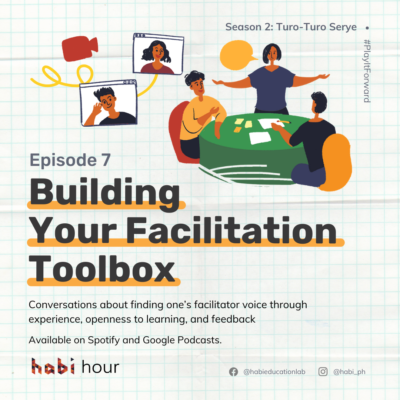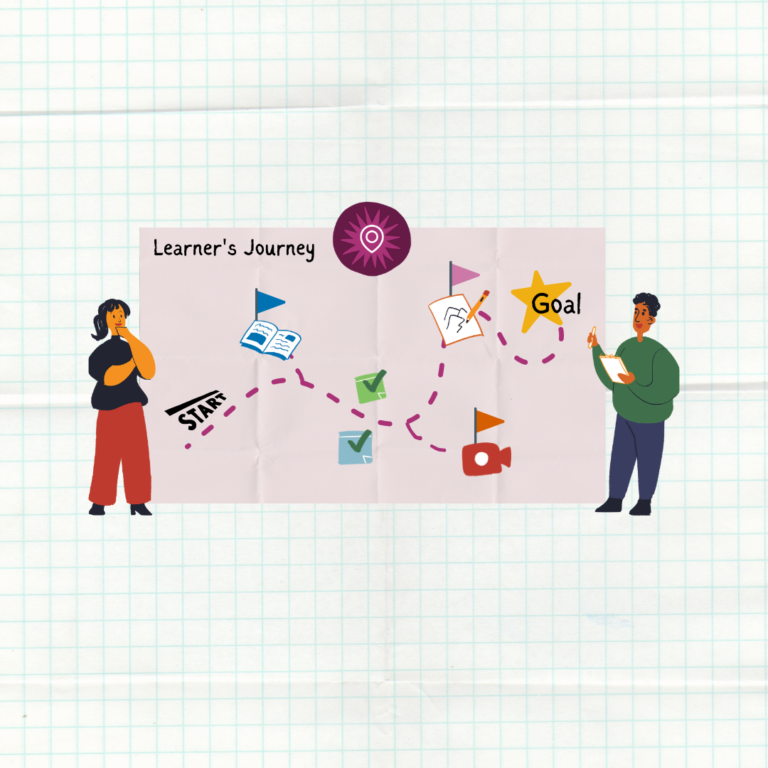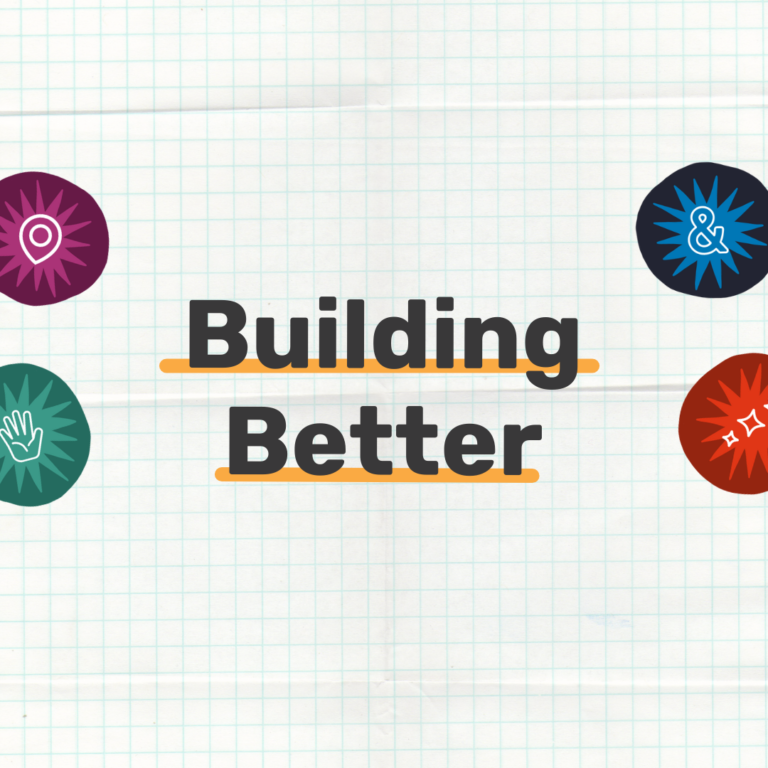Conversations about finding one’s facilitator voice through experience, openness to learning, and feedback
Overview
21 May 2021 | 18 min and 58s
In this week’s episode of the Turo-Turo Serye, we sit down with Joan and Joseph, Manghahabi Community members and fellow learning experience designers, to talk about their unending journey of finding their facilitator selves. They talk about their proudest and most challenging experiences as facilitators, as well as bits and pieces of what they have in their facilitation toolbox.
Transcript
Introductions and Check In
Joan: Ako ba paano ko ba nahanap yung sarili kong boses sa pagfa-facilitate. Gagamitin ko yung tagline ng Habi – it’s my general interest of making learning happen. Naks! [laughs]
Lacey: Yes [laughs]
Joan: Pwede na ba? Pwede na?
Joseph: [laughs]
Joan: Pero naniniwala ako sa kanya. So naniniwala talaga ako na learning should never stop and I’m keen to support.
Lacey (voice over): That was Joan, isang learning experience designer, learning facilitator at kabahagi ng ating Manghahabi Community. Makakasama natin siya at si Joseph na isa ring LXD at learning facilitator sa episode na ito on Building Your Facilitation Toolbox. Ako si Lacey ang inyong host for today. Tara, at magkwentuhan tayo!
[Habi Hour Intro]
Lacey: Hello, Joan and Sir Joseph! Katulad ng mga Habi workshops natin noon, magsisimula rin tayo sa check in. Check-in question natin for today. Hmm. Give me like the first thing that comes to your mind when you hear the word ‘facilitation’ and what is the associated feeling dun sa word na ‘yon?
Joan: Whenever I hear the word facilitation the first thing that comes to mind is process. And the feeling associated with it is it’s a little bit arduous so medyo may hirap pero may ginhawa, so fruitful din.
Joseph: For me when I hear the word facilitation I think of blank slate I come from a state of not knowing much, pero merong baon so the pro– iyong sabi nga ni Joan, the process comes in para malamnan ‘yung blank slate na ‘yon. And ang naa-associate ko sa kanya always is curiosity and open-mindedness. Kasi as a facilitator, for me. ‘Yan yung lagi kong baon. Being curious about what people would say and how they would respond to to the process and of course being open to accepting kung ano man ‘yung ‘yung kahihinatnat nung proseso.
Lacey: ‘Pag naririnig ko talaga ‘yung word na facilitation ang ang unang pumapasok sa isip ko ay guiding. So more of guiding the participants or the learners at ‘yung feeling na na-associate ko or nararamdaman ko ‘pag ako rin mismo ay nag fafacilitate ay may excitement at the same time plus one kay Sir Joseph na may curiosity din to what I will impart with the learners and what I will learn also from them.
Kuwentuhan
Lacey (voice over): Ikinuwento nila Joan at Joseph kung paano sila nagsimula sa larangan ng facilitation at kung sinu-sino ang kanilang mga target learners.
Joan: I work for a global non profit so my main work is to support our fifty-five (55) offices all over the world in designing audience-centric or people-powered campaigns. So, I do that facilitating learning on different approaches and methodologies of of campaign design basically. My core audiences, if if I can call them core audiences, are staff. So, who are working on engaging our target audiences either face to face or digitally. Pero siyempre since pandemic, most of it is through digital spaces. So I don’t necessarily work with learners in an academic set-up so here siguro once we go through the conversation I define learners as someone who has general interest and openness to learning. Siguro ‘yun ‘yung space to where I do my facilitation.
Joseph: I used to work also for a non-profit early in the 2000’s. Then, from there I’ve been facilitating a lot of youth programs already and community organizing. And then I got into a consulting firm when I left the NGO world. So when I say OD it’s really about implementing OD intervention mga workshops either training and de– learning and development sa mga staff or building up a company or breaking up an organization ‘yong mga ganon na when it comes to organizational development. So, we do a lot of assessments tapos dun pumapasok ‘yung pumapasok naman dun ‘yung facilitation cause namin kasi we do a lot of FGDs. We do a lot of meeting facilitation, we do a lot of leadership workshops, coaching workshops, supervisory training and of course a lot of team building programs.
Lacey (voice over): Sa bahaging ito napagusapan namin ang mga kaniya-kaniyang karanasan sa pagfacilitate. Anu-ano ang proudest moments at mga learnings from facilitating?
Joan: Sa konsepto ng L&D mayroong tinatawag na return of learning ‘di ba. So, ‘you see the the return of investment or the amount of investment in terms of time resources ‘pag binalik na nila sa’yo ‘yong kung ano iyong natutunan nila. Kung nagamit na ba nila iyong mga natutunan nila. It always feels good when after post na eh actually hindi during. Post the training or post the the event itself is when they started reaching out to you because they are already using it in practice. Iyon ‘yung iyon ‘yung isa sa proudest for me.
Joseph: Plus one ako dun kay sa sabi ni Joan na iyon nga if you see na iyong learning is immediately used immediately implemented. Halos pareho pala tayo ng ginagawang workshop, Joan. A few weeks back I did a resource mobilization workshop for CSRs. Then immediate talaga, kita ko na yung tools, nalamanan nila yung form, meron silang plan for the next 2-3 years.
Lacey (voice over): Kung merong mga proudest moments of facilitation, meron ding challenging ones. Pero kadasalan, sa mga naeencounter natin na challenges, dito tayo nakakapagreflect on our own style of facilitation and how we can possibly improve further.
Joseph: For lack of a better tem, rigid. Mga ganun na participants na ang hirap buhatin. Yung mabigat na participants. Mahirap ibagsak yung creative agad in that kind of participants. Yung tipong, ano muna, medya-medya lang. Ginawa ko is inunti-unti na ma-introduce different ways of doing the workshop. And they responded.
Joan: For me it’s always about facilitating difficult people [laughs]. Some people are difficult and it’s okay. It’s part of of of life ‘di ba whether facilitation or otherwise. Difficult people will be there. So, the challenge there is that often difficult people take up too much space. SO they take space from other people or other participants in the room. So obviously there is that uneven or imbalance in the power structure. Minsan iyon yun eh, yung mga posisyon na nasa loob ng kuwarto, it creates that imbalance, whether formal or informal power. And most of the time, difficult people sa experience ko, they tend to make the space very hostile or negative. Iyon yung challenge. Dahil nga importante ang energy sa room diba, whether it’s a calm or high energy space, energy is important. Period. Para madaloy yung proseso.
So yung nangyari doon is that, how I usually handle it, and actually I learned it from another facilitator as well. Ginagamit ko na siya noong natutunan ko siya. Sa face-to-face set up, for example, if a participant is oversharing or started creating this hostile environment, the approach would be to literally give them a time limit of how much they can use that negative space. So, it can be a minute or two. Talaga literal sabihin mo na parang okay I’m giving you one minute to to finish your point to wrap up and to go towards what the point of your sharing is.
‘Yung isa pang ginagawa namin, tawag sa kaniya softbox or one minute speeches. Halimbawa kulang ka sa time. So kailangan madala mo yung mga tao from Point A to Point B, pero para sa iyo, importante pa rin iyong sasabihin nila. Lalo na may difficult people around. I try to, before breaks, to give them 1 minute to do what they want. Usually may digital timer na naka-flash sa screen. Tapos malapit ako sa volume. So kapag may 1 minute na, patay na yung mic [laughs]. So iyong iba, natatawa. It also gives some energy to the room.
Joseph: Ang sama. [Laughs]
Joan: [laughs] Hindi siya masama kasi you were very clear at the beginning na you were giving them 1 minute.
Joseph: That’s the mechanics kumbaga.
Joan: Oo, that’s the mechanics. So difficult people you can manage them. Just give them the space, the time, but being clear also to what’s negotiable and what’s not negotiable.
Lacey (voice over): Narinig natin mula kay Joan kung papaano siya maghandle ng difficult people when facilitating. Ngayon naman na most of our facilitation happens online, anu-ano ang mga dinagdag o iniba natin sa way ng ating pagfafacilitate?
Joseph: Ako I’m not sure if it’s deliberately iniba by my by my volition, or dahil yun lang yung available tools na pwedeng gamitin. For me accepting na lang talaga that these are the tools that I have and we make use, we make do of what’s there.
Joan: Nagstart ako sa tools. So nag-assess ako ng mga existing digital tools na pwedeng gamitin. Tas I tried to think of ways na adapt it to how I usually do things. So tinatry ko. Will this work? Will this not work? Etcetera. Why? Ano lang siya, triall and error in some ways. Some, some tools work for others, others just don’t. Yun yung isa.
Tas yung pangalawa is that how I organize time Yun talaga yung pinaka importante. Dati yung mga one hour na meeting, kelangan mas malaki na siya ngayon. So pag sinabi mong one hour meeting, sasabihin ko sayo kailangan natin ng one and a half hour, kung gusto mo ng one hour na meeting. Kasi eh, yung virtual gatherings or mga meetings, you need to inject more intentional breaks. Taposhindi pa rin nawawala yung even naman in face-to-face, we try to bridge yung physical at digital learning spaces. Sometimes we still use tools digitally kahit na face-to-face siya. So similarly, try to incorporate using still pen and papers or using anything that’s within your environment. Yun pa rin yung ko. Marami akong kinuha dun sa Habi Learning Design na ginagawa ni Gerson na mga activities for check-in, ganyan ganyan. Ginagamit ko siya na parang okay useful to.
Lacey (voice over): As we wrap up our kwentuhan, nag-iwan sina Joan at Joseph ng ilang mga tips on finding your own facilitation style and on how to do powerful facilitation for learning.
Joan: Ito yung madali na part – learn as many tools as you can. When you have lots of tools, then it can be modular in your head. Kukunin ko na lang – boom, boom, boom – ito yung kailangan ko. Pero at the end of the day, you still need to try, test and evaluate. Kailangan siya, sabi nga sa Design Thinking, kailangan mo mag-prototype. Tingnan mo if it works. So don’t be afraid to experiement.
Always ask for feedback. It gives you space to reflect and grow in the process. Naks, ang dami kong kinuhang parang quotable quotes from Habi! [everybody laughs] Pero naniniwala talaga ako doon! Kaya nga ako, go na go ako sa Habi eh. Support tayo diyan. Iyan talaga yung gusto natin mangyari.
Joseph: Ito at least for me nag-work. Puwede niyo ring subukan. Try to create scenarios in your head. Parang yung mga ano, mga sports people… ano bang term para sa sports people?
All: Athletes? [laughs]
Joseph: Parang mga athletes. They imaging yung routine nila before they go. For you as well, try to imagine as much as you can how the workshop will move, and then get as much scenarios. Paano kapag nangyari ito? Ganoon.
Joan: It took a lot of practice and learning what’s on my hand. So meron yung formal learning on facilitation, tas meron din yung mga informal, yung learning about your worst facilitation experiences.
Lacey: Yeah.
Joan: Hindi ko gagawin iyan pag ako, pero ginagawa mo rin pala minsan. Yung mga ganyan. So it didn’t happen overnight. So ano siya, parang lifelong learning din yung paghahanap dun sa boses mo.
Joseph: Get experience as much as you can. Facilitate as much as as you can. Get opportunities for you to talk. Go speak in front of people. Facilitate a workshop as much as you can. Of course you have to prepare for it also. Volunteer to be a workshop facilitator.
The more experience you get, the more chances of winning. Pero it’s not just going through it, I like yung sabi nga ni Joan na you need to get feedback. But as much as you can also get feedback, and also you need to self-assess. You get the feedback and then you assess yourself. At the end of each opportunity or each experience that you get ask yourself questions na ‘Did I achieve the objective?’ ‘What went well?’ ‘What did not go well?’. And be accepting of whatever it is na mai-feedback sa iyo. And then learn from all the experience that you’re getting.
I don’t know how this would go with people, pero try not to get too hung up on other facilitators or try to emulate. Yung tipong meron kang, “Ah, this is the best facilitator!” I think there’s a time for you to make use kung anuman yung processing ibang facilitator. Pero somehow at some point, you need to understand na meron kang sariling voice. You have your own style. Habang nagseself-assess ka, getting feedback and all, you get to understand who you really are as a facilitator. And iyon ang gamitin mo.
Check out
Lacey (voice over): There’s no one way to facilitate. No best way to facilitate.
Facilitating is challenging, pero kapag binalikan talaga natin yung mga naranasan natin and we use those experiences to continue improving ourselves, we can feel that we are growing in terms of our facilitation skills. As we listened and gained inspiration from Joan and Joseph’s experiences, narinig natin yung wisdom na maaaring makatulong sa pagbuo sa atin bilang mga facilitator, habang patuloy nating sinusubukan ang iba’t ibang techniques mula dito. Ang facilitation toolbox natin – hindi rin magkakapareho. Pero kayang-kaya nating magtulungan na punuin at pagyamanin ang facilitation toolbox ng bawat isa.
Kayo, meron ba kayong facilitation tips? Comment ninyo dito as we continue to build our facilitation toolboxes! Aabangan namin!
Pero sa ngayon, check out tayo!
Lacey: Complete the sentence tayo. A powerful facilitator makes learning….
Joan: Thoughtful, collaborative, and creative.
Joseph: fun, interesting, useful, and internal. Ayun.
Lacey: A powerful facilitator makes learning happen. [LAUGHS]
[Habi Hour Outro]



